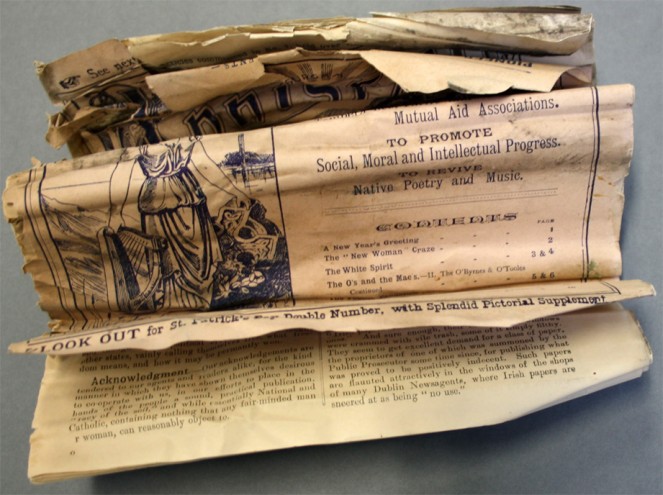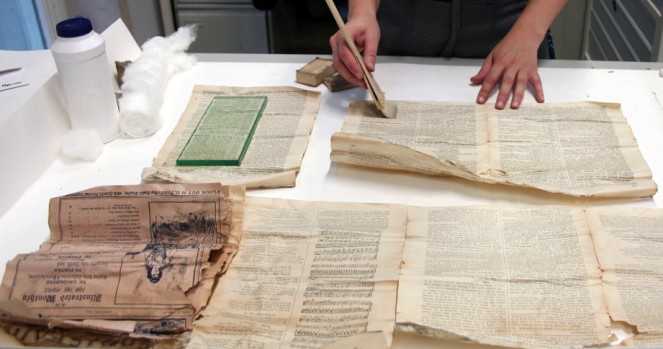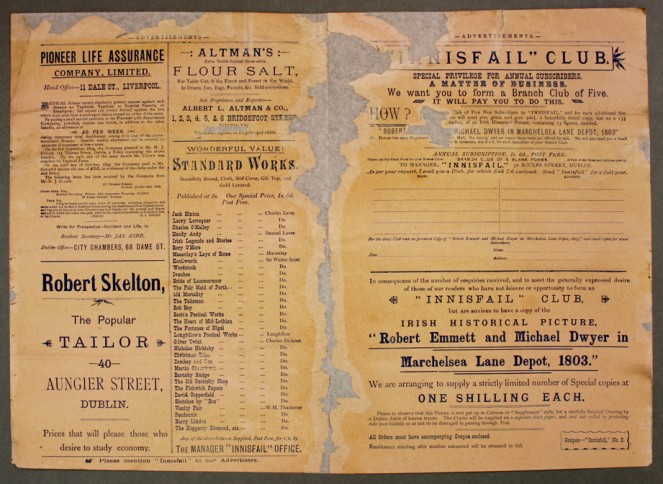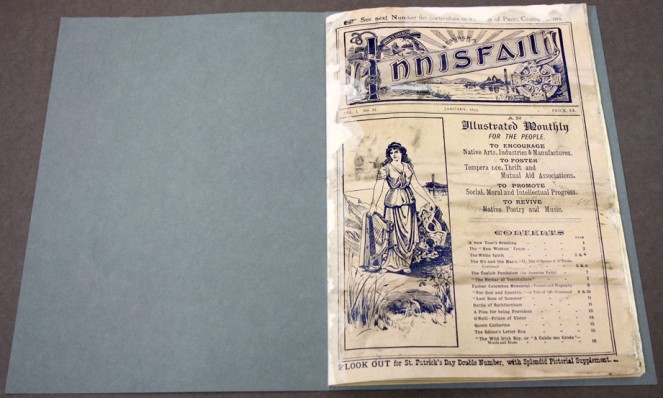by Justin Furlong (Newspaper Librarian); Alexandra Nederlof (Student Conservation Intern from the University of Amsterdam) and Louise O'Connor (Conservator)
In February 2012 we were contacted by Tim Lynch, Professor of Neurology at the Dublin Neurological Institute. Ten years ago, during renovations of the Institute’s building at No. 57 Eccles Street in Dublin, an issue of a journal called Innisfail was found stuffed into a window to act as padding and support. Professor Lynch asked if the NLI would be interested in acquiring this item, and as we did not have this early issue we were delighted to accept. Innisfail was an illustrated monthly journal designed “to encourage Native Arts, Industries & Manufacturers to Foster Temperance, Thrift and Mutual Aid Associations”. As yet, we don’t know a lot about this journal, but interestingly the editor’s address was 58 Eccles Street – so we’re guessing that’s how it ended up as window insulation at no. 57! This issue of Innisfail (Vol. 1, no. 2, January 1895) can now be consulted in the Library’s main Reading Room.

A very rumpled and crumpled issue of Innisfail, before encountering tender loving care from Alexandra and Louise in Conservation
When it arrived here, this issue of the Innisfail was so crumpled up, torn and dirty that it was very difficult to read. It consists of 8 pages in a faded light pink cover, with many paper losses and some mould damage, but otherwise it had survived surprisingly well having lived in a wall for possibly over a century! Alexandra and Louise will talk us though their conservation treatment, which focused on making this 1895 issue of the Innisfail accessible to new generations of readers.
Unfolding and dry surface cleaning
After discussion with colleagues, this issue of the Innisfail was photographed and condition assessed to see what was possible to do. It was carefully unfolded as the paper was very brittle with many tears, and handling it risked tearing the paper more.

Gently removing surface dirt from Innisfail
Conservation should always follow the least interventive option, so we decided to fully treat the brittle pink cover but that the inner pages within did not require such extensive work.
All of the pages were then surface-cleaned with a soft brush, smoke sponge and soft eraser. First the soft brush removed the loose dust and dirt particles from the paper. Then a smoke sponge was used; this is a synthetic (latex free) sponge with honeycomb structure which helps to trap and actively remove dirt instead of sweeping it over the surface.

Methyl-cellulose solution, used to strengthen the paper cover of the Innisfail
Where the dirt was more stubborn in certain sections, we used a soft eraser or eraser powder. It is rarely possible to remove all dirt particles however, as these can bond chemically with the paper fibres.
Washing
To remove soluble acidic compounds in the paper fibres, we next used a process called controlled washing on the Innisfail's pink cover. This reduces the brittleness of the paper, making it easier to handle and repair after drying and pressing. These acidic compounds have a yellow colour and once we removed them, the cover appeared a brighter pink! The cover was also resized with a thin solution of methyl-cellulose to give strength to the paper, improving reader handling.
Pressing
As an organic polymer, moisture is essential to cellulose – the main component in paper. During paper manufacture, cellulose fibres are mixed with water to make a paper sheet that aids hydrogen bonding of each cellulose compound to another.
As the Innisfail had been crumpled and rolled up for so many decades, it was quite stubborn in refusing to stay flat. This is because paper, just like our skin, is also hydroscopic – it absorbs and releases moisture in the air. The cellulose fibres, responding to the air, had therefore changed into a rolled state. To flatten the pages, we gently introduced moisture into the paper by lightly spraying with water using a fine mist sprayer.

Innisfail cover at the stage where it was washed, pressed, and ready for repair
The paper fibres absorbed the moisture and swelled, and the creases and curls in the paper steadily lost resistance. We then dried the pages in a paper press over a few days. While in the press, the paper fibres are restricted and slowly dry under the flat pressure. While it may seem counter-intuitive, water really is necessary to help change the "memory" of paper from crumpled to flat during the pressing process; without moisture, pressing doesn’t really work.

Innisfail cover after conservation
Having said that, this time lightly spraying the pages with water and then pressing them did not work! The paper was just too damaged from mould (which destroys the cellulose structure of paper) and the pages would not press flat. So washing and pressing, as we had done with the pink cover of the Innisfail, was needed. Once the pages were finally flat, we were able to begin repairing the tears. We chose two methods of repair – heat-set tissue for the cover tears, and one starch and Japanese paper for the Innisfail's inner pages. Once the tears were repaired, the cover and sheets were assembled and sewn into an archival blue card cover.

Repaired inner pages of Innisfail
The repairs were not visually matched with the original pink cover, as this would have taken a very long time. This 1895 issue of the Innisfail is rare, but it is not unique, and in conservation we always have to pick our battles. Moreover, the damage incurred by this late-19th century periodical throughout the many years that it had lived in a wall at 57 Eccles Street is part of its history, its war-wounds!

Ta Dah! The January 1895 issue of Innisfail restored and ready for future generations of readers. NLI ref. 1K 2913
